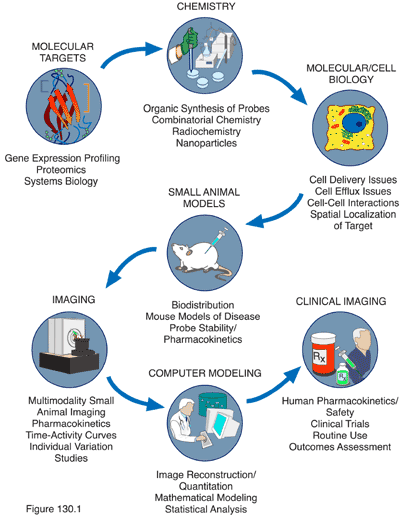ICMIC@Stanford 2005 - 2010
The vision of ICMIC@Stanford is to bring together researchers from various disciplines to form synergistic teams that will make significant advances in the use of multimodality molecular imaging strategies for better linking pre-clinical models of cancer with the clinical management of cancer. Members of these teams will include trainees that will gain access to a highly multidisciplinary experience, and who will become well-equipped to establish independent, multidisciplinary research programs. Projects will mainly include those that have a high potential for linking pre-clinical imaging models with clinical imaging for improved cancer patient management. To leverage the excellent existing resources at Stanford, ICMIC@Stanford will be fully integrated into the Molecular Imaging Program at Stanford (MIPS) (http://mips.stanford.edu), a new inter-departmental program involving scientific leaders and new young investigators in the fields of imaging, cell and molecular biology, molecular pharmacology, oncology, immunology, chemistry, engineering, applied physics, biomathematics and computational sciences who are highly committed to rapidly pushing the field of multimodality molecular imaging forward.
The Molecular Imaging Program at Stanford is directed by Dr. Sanjiv Sam Gambhir, Professor and Chair of the Department of Radiology, and is co-directed by Dr. Chris Contag, Professor of Pediatrics and of Microbiology and Immunology and, by courtesy, of Radiology and Director of Stanford Center for Innovation in in vivo Imaging (SCI3). Together, Drs. Gambhir and Contag form a highly unique leadership team that spans the diversity of disciplines involved in the field of multimodality molecular imaging. The MIPS currently has 13 full members (including Drs. Contag and Gambhir) from 5 different departments and 30 associate members from 11 different departments. Full members have greater than 70% of their research efforts focused on multimodality molecular imaging whereas Associate members are actively using multimodality molecular imaging but have a focus in another scientific discipline.
Multimodality Molecular Imaging requires the interactions of several disciplines as shown below. The MIPS covers the breadth of disciplines needed to perform successful research in multimodality molecular imaging. Over the last year we have successfully enhanced the MIPS core faculty by adding 6 new faculty recruits to MIPS (Drs. Sandip Biswal, Xiaoyuan (Shawn) Chen, Samira Guccione, Craig Levin, Jianghong Rao and Andy Quon, all in Radiology) plus one recruit in Radiation Oncology (Ted Graves) and one in Physics (Mark Schnitzer). It is important to note that although many of the MIPS faculty are focused on cancer research, several are studying other areas including neurosciences and cardiovascular biology.

- Maximize interaction among multidisciplinary investigators for a coordinated effort in molecular and cellular imaging of cancer
- Coordinate and manage the multidisciplinary programmatic cores and collaborative research efforts, and integrate these into the specialized research activities of the University for an effective research endeavor that pushes the envelope of scientific discovery
- Understand basic biological mechanisms of cancer that will lead to intervention strategies that will aid in the design and testing of innovative therapies that strike at the molecular foundation of oncogenesis and the minimal disease states that lead to relapse
- Maximize the use of the specialized resources and program strengths with integrated projects that aim to advance novel imaging approaches in oncology
- Provide training opportunities for students and scientists at all career levels to advance the field of in vivo cellular and molecular imaging, nationally and internationally.

